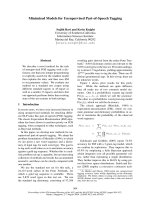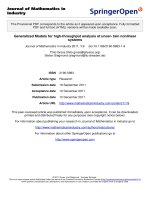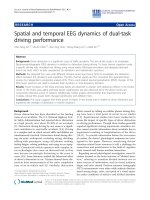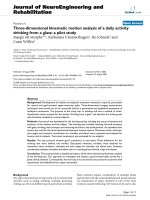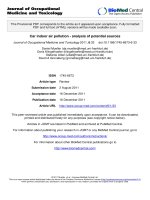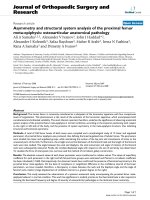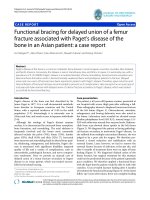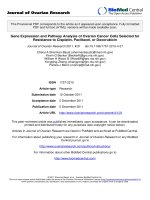Báo cáo hóa học: " Generalized Models for high-throughput analysis of uncer- tain nonlinear systems" pdf
Bạn đang xem bản rút gọn của tài liệu. Xem và tải ngay bản đầy đủ của tài liệu tại đây (1.42 MB, 4 trang )
This Provisional PDF corresponds to the article as it appeared upon acceptance. Fully formatted
PDF and full text (HTML) versions will be made available soon.
Generalized Models for high-throughput analysis of uncer- tain nonlinear
systems
Journal of Mathematics in Industry 2011, 1:9 doi:10.1186/2190-5983-1-9
Thilo Gross ()
Stefan Siegmund ()
ISSN 2190-5983
Article type Research
Submission date 19 September 2011
Acceptance date 12 December 2011
Publication date 12 December 2011
Article URL />This peer-reviewed article was published immediately upon acceptance. It can be downloaded,
printed and distributed freely for any purposes (see copyright notice below).
For information about publishing your research in Journal of Mathematics in Industry go to
/>For information about other SpringerOpen publications go to
Journal of Mathematics in
Industry
© 2011 Gross and Siegmund ; licensee Springer.
This is an open access article distributed under the terms of the Creative Commons Attribution License ( />which permits unrestricted use, distribution, and reproduction in any medium, provided the original work is properly cited.
,2
1
Generalized Models for high-throughput analysis of uncer-
tain nonlinear systems
Thilo Gross , Stefan Siegmund
∗ 2
1
Max-Planck Institute for the Physics of Complex Systems, N¨othnitzer Str. 38, 01187 Dresden, Germany
2
Technical University Dresden, Department of Mathematics, Center for Dynamics, 01062 Dresden, Germany
Email: Thilo Gross - , ; Stefan Siegmund
∗
- ;
∗
Corresponding author
Abstract
Purpose — Describe a high-throughput method for the analysis of uncertain models, e.g. in biological research.
Methods — Generalized modeling for conceptual analysis of large classes of models.
Results — Local dynamics of uncertain networks are revealed as a function of intuitive parameters.
Conclusions — Generalized modeling easily scales to very large networks.
Keywords — Generalized modeling; high-throughput method; uncertain models; biological research.
1 Background
The ongoing revolution in systems biology is reveal-
ing the structure of important systems. For under-
standing the functioning and failure of these sys-
tems, mathematical modeling is instrumental, cp.
Table 1. However, application of the traditional
modeling paradigm, based on systems of specific
equations, faces some principal difficulties in these
systems. Insights from modeling are most desirable
during the early stages of exploration of a system,
so that insights from modeling can feed into experi-
mental set ups.
However, at this stage the knowledge of the sys-
tem is often insufficient to restrict the processes to
specific functional forms. Further, the number of
variables in the current models prohibits analytical
investigation, whereas simulation does not allow ef-
ficient exploration of large parameter spaces.
2 Method
Here we present the approach of generalized model-
ing. The idea of this approach is to consider not
a single model but the whole class of models which
are plausible given the available information. Mod-
eling can start from a diagrammatic sketch, which is
translated into a generalized model containing un-
specified functions. Although such models cannot
be studied by simulation, other tools can be applied
1
more easily and efficiently than in conventional mod-
els. In particular, generalized models reveal the dy-
namics close to every possible steady state in the
whole class of systems depending on a number of
parameters that are identified in the modeling pro-
cess.
3 Results
In the past it has been shown that generalized mod-
eling enables high-throughput analysis of complex
nonlinear systems in various applications [1-2]. In
particular it was shown that generalized models can
be used to obtain statistically highly-significant re-
sults on systems with thousands of unknown param-
eters [3].
4 Discussion
For illustration consider a population X subject to
a gains G and losses L,
d
dt
X = G(X) − L(X) (1)
where G(X) and L(X) are unspecified functions. We
consider all positive steady states in the whole class
of systems described by (1) and ask which of those
states are stable equilibria. For this purpose denote
an arbitrary positive steady state of the system by
X
∗
, i.e. X
∗
is a placeholder for every positive steady
state that exists in the class of systems. For deter-
mining the stability of X
∗
one can use dynamical
systems theory and evaluate the Jacobian of (1) at
X
∗
J
∗
=
∂G
∂X
X=X∗
−
∂L
∂X
X=X∗
.
For expressing the Jacobian as a function of eas-
ily interpretable parameters we use the identity
∂F
∂X
X=X
∗
=
F (X
∗
)
X
∗
∂ log F
∂ log X
X=X
∗
, which holds for
positive X
∗
and F (X
∗
). We write
J
∗
=
G(X
∗
)
X
∗
g
X
−
L(X
∗
)
X
∗
X
.
where g
X
:=
∂ log G
∂ log X
|
X=X
∗
and
X
:=
∂ log L
∂ log X
|
X=X
∗
are so-called elasticities, a term mainly used in eco-
nomics. The prefactors
G(X
∗
)
X
∗
and
L(X
∗
)
X
∗
denote per-
capita gain and loss rates, respectively. By (1) gain
and loss rates balance in the steady state X
∗
such
that we can define
α :=
G(X
∗
)
X
∗
=
L(X
∗
)
X
∗
.
which can be interpreted as a characteristic turnover
rate of X. We can thus write the Jacobian at X
∗
as
J
∗
= α(g
X
−
X
).
To interpret g
X
and
X
note that for any power law
L(X) = mX
p
the elasticity is
X
= p. Constant
functions have an elasticity 0, all linear functions an
elasticity 1, quadratic functions an elasticity 2. This
also extends to decreasing functions, e.g. G(X) =
m
X
has elasticity g
X
= −1. For more complex functions
G and L the elasticities can depend on the location of
the steady state X
∗
. However, even in this case the
interpretation of the elasticity is intuitive, e.g. the
Holling type-II functional response G(X) =
aX
k+X
is
linear for low density X (g
X
≈ 1) and saturates for
high density X (g
X
≈ 0).
So far we succeeded in expressing the Jacobian of
the model as a function of three easily interpretable
parameters. A steady state X
∗
in a dynamical sys-
tem is stable if and only if the real parts of all eigen-
values of the Jacobian are negative. In the present
model this implies that a given steady state is stable
whenever the elasticity of the loss exceeds the elas-
ticity of the gain g
X
<
X
. A change of stability
occurs if g
X
=
X
as (1) undergoes a saddle-node
bifurcation.
5 Conclusion
The simple example already shows that generalized
modeling
• reveals boundaries of stability, valid for a class
of models and robust against uncertainties in
specific models
• avoids expensive numerical approximation of
steady states and can be scaled to high-
dimensional models
Also in larger models it is generally straight forward
to derive an analytical expression that states the Ja-
cobian of the generalized model as a function of sim-
ple parameters. This Jacobian can then analyzed
analytically or numerically by a random sampling
2
Allauthorsreadandapprovedthefinalmanuscript.
procedure. Both approaches are illustrated in a re-
cent paper on bone remodeling [4]. Here, the gen-
eralized model analysis showed that the area of pa-
rameter space most likely realized in vivo is close to
Hopf and saddle-node bifurcations, which enhances
responsiveness, but decreases stability against per-
turbations. A system operating in this parameter
regime may therefore be destabilized by small vari-
ations in certain parameters. Although theoretical
analysis alone cannot prove that such transitions are
the cause of pathologies in patients, it is apparent
that a bifurcation happening in vivo would lead to
pathological dynamics. In particular, a Hopf bifur-
cation could lead to oscillatory rates of remodeling
that are observed in Paget’s disease of bone. This
result illustrates the ability of generalized models to
reveal insights into systems on which only limited
information is available.
6 Competing Interests
The authors declare that they have no competing
interests.
7 Authors’ contributions
The authors have developed this note jointly. The
method of generalized modeling was invented by the
first author.
References
1. Gross T, Feudel U: Generalized models as a univer-
sal approach to the analysis of nonlinear dynamical
systems. Phys. Rev. E 2006, 73:016205.
2. Steuer R, Gross T, Selbig J, Blasius B: Structural ki-
netic modeling of metabolic networks. PNAS 2006,
103:11868.
3. Gross T, Rudolf L, Levin SA, Dieckmann U: General-
ized models reveal stabilizing factors in food webs.
Science 2009, 320:747.
4. Zumsande M, Stiefs D, Siegmund S, Gross T: General
analysis of mathematical models for bone remod-
eling. Bone 2011, DOI:10.1016/j.bone.2010.12.010
3
Diagrammatic representation
˙
X = G(X) − L(X) Generalized model
˙
X =
aX
k+X
− mX
p
Conventional model
Table 1: Three different levels of modeling.
